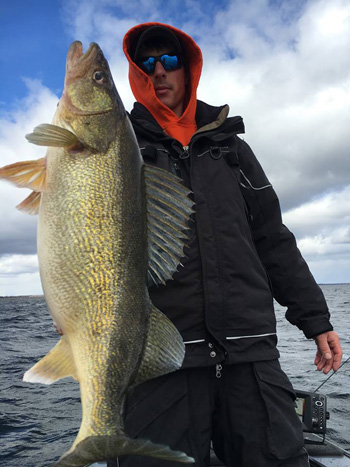Blade Baits are Hot!
Posted by Walt Matan, Chief Product Designer on Feb 27th 2020
Posted by Walt Matan, Chief Product Designer on Feb 27th 2020
If you're a river fisherman, chances are you've got some blade baits in your tackle box. You probably don't use them very much...which is a big mistake, because when the water cools down to near freezing it's a time when the vibration of blade baits creates a motion that walleye,sauger and white bass can't resist!
A blade bait is a metal crank bait that features two sets of treble hooks, one on each end. It relies on vibration and sound to get the fish to react on a reaction strike. A blade bait consists of a flat metal spoon with a weighted nose. The blade bait will vibrate on the retrieve and vibrate on the lift. Blades baits are fairly heavy for their size, so they cast like bullets and get down to the fish zone fast.
One thing about blade baits...fish will still slam the bait even when the bite is slow. We're talking about when a jig fisherman might have to add a stinger hook to his jig, because the fish are nipping the tail.

Dams are great spots to use blade baits. Walleye, sauger and white bass will all make a migration to the dam during cold water periods and they become vulnerable to rippin' blade baits cast up to the dam. Most fish will hit on the first few cranks of your reel, so be ready to set the hook. A slow retrieve, just fast enough to keep the blade vibration is key. Mix the retrieve up with a slow pumping motion for violent strikes.
Creek mouths are also hot spots. Cast blade baits to the mouth of the creek and to the shorelines upriver and downriver of the creek. Depending on the size and scope of the river you are fishing, you might need to be out in the middle of the river channel and cast towards shore.
Holes that hold deeper water are also great areas. Holes are usually found in the bend in the river channel or around bridges. You’ll want to fish the holes vertically by dropping the blade to bottom and jigging up. Many anglers will rip the blade up too hard. This is not as effective as a quick 12 inch lift.
Bridges are prime areas because they have deep holes, current and eddies. You can rip vertically or cast towards shore. Try both sides of the river and be ready to set the hook! One thing to remember about blades is that they are heavy, so they cast far and fall quickly. When casting towards shore, you’ll want to get the blade moving as soon as it hits the water, so you don’t snag up.
My favorite blade baits are those made by B-Fish-N Tackle. Their B3 Blade baits come in 1/4 and ½ ounce sizes which are perfect for most species. What sets the B3 Blades apart is their high quality Mustad Hooks and split rings, their hot paint and plated finishes and perfect balance for the highest vibration.
I like to use bait casting rods and reels for working blades. I also prefer mono since it has more stretch. Since most hits are fast and furious often times when you rear back to set the hook with a superline, the blade rips free. 10 to 14 pound test line is ideal on a medium seven foot rod and a small bass style reel.
Blade Baits are often overlooked, but when the water is cold, they really shine!
You can find all our blade baits here.
If you enjoyed this article, you may also like: